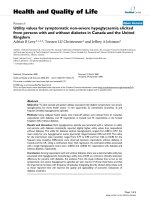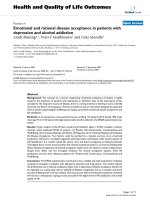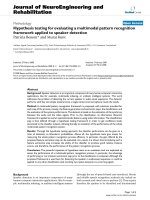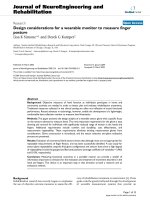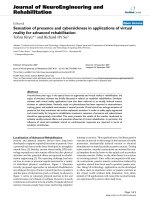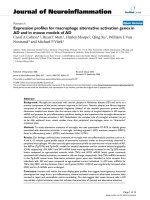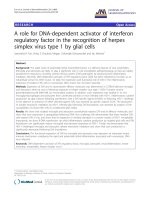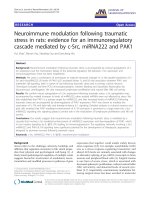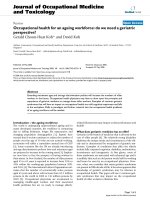báo cáo hóa học: " Selected basis for PAR reduction in multi-user downlink scenarios using lattice-reduction-aided precoding" doc
Bạn đang xem bản rút gọn của tài liệu. Xem và tải ngay bản đầy đủ của tài liệu tại đây (356.46 KB, 11 trang )
RESEARC H Open Access
Selected basis for PAR reduction in multi-user
downlink scenarios using lattice-reduction-aided
precoding
Christian Siegl
*
and Robert FH Fischer
Abstract
The application of OFDM within a multi-user downlink scenario is considered. Thereby, two problems occur. First,
due to OFDM, the transmit signal exhibits a large peak-to-average power ratio (PAR). Second, the multi-user
interferences have to be equalized (or precoded) at the transmitter side. In this article, we address combined
precoding and PAR reduction. As precoding schemes sorted Tomlinson-Harashima precoding (sTHP) and its lattice-
reduction-aided variant (LRA-THP) are considered. In order to reduce the PAR, we review the scheme selected
sorting (SLS), which is a combined approach of PAR reduction and precoding with sTHP. Based on this idea, the
novel PAR reduction scheme selected basis (SLB) is introduced which combines PAR reduction with the precoding
approach LRA-THP. It can be shown that SLB achieves very good PAR reduction performance and hardly influences
the error performance. Both schemes, SLB and SLS, are compared with simplified selected mapping (sSLM), the
only PAR reduction scheme from the SLM family, which can be applied in multi-user downlink scenarios. The
comparison is done on the basis that the respective schemes exhibit the same computational complexity. In terms
of PAR reduction performance, it turns out that sSLM outperforms SLS, whereas the performance of sSLM and SLB
is similar. Noteworthy, the great benefit of SLB or SLS is that no side information has to be communicated to the
receiver as it is necessary with sSLM. Moreover, using SLB, full diversity error rate performance is possible with only
low-PAR transmit signals.
Introduction
Orthogonal frequency-division multiplexing (OFDM) [1]
is a very popular scheme for equalizing the temporal
interferences caused by frequency-selective channels.
One essential drawback of OFDM systems is large peaks
in the transmit signal. This property leads to signal clip-
ping at the nonlinear power amplifier, which in turn
leads to very undesirable out-of-band radiation. In order
to avoid violating spectral masks, a transmitter-sided
algorithmic control of the peak power is essential. Such
algorithms are denoted as peak-to-average power ratio
(PAR) reduction schemes. PAR reduction techniques for
single-antenna OFDM systems have been well a nalyzed
in the literature. The most prominent are selected map-
ping (SLM) [2], partial transmit sequences (PTS) [3],
active constellation extension (ACE) [4] or tone reserva-
tion (TR) [5].
In order to satisfy the demands for high data rates,
modern communication systems use multiple antennas
at transmitter and receiver to increase the channel capa-
city [6]. T he problem of out-of-band radiation gets even
more serious for such a multiple-input/multiple-output
(MIMO) system. Since the transmitter is equipped with
multiple antennas, out-of-band radiation is generated as
soon as the signal at only one antenna is clipped.
Hence, the reduction of the signal’speakpoweriseven
more relevant for such systems.
Recently, peak power reduction schemes, developed
for single antenna systems, have been transferred to the
MIMO case. Possible extensions for the popular scheme
SLMhavebeenproposedin[7-9].However,inmany
cases these extensions have only been discussed for
multi-antenna point-to-point scenarios where the equal-
ization of the multi-antenna interferences can be accom-
plished at the receiver side.
* Correspondence:
Lehrstuhl für Informationsübertragung, Friedrich-Alexander-Universität
Erlangen-Nürnberg Cauerstrasse 7/LIT, 91058 Erlangen, Germany
Siegl and Fischer EURASIP Journal on Advances in Signal Processing 2011, 2011:17
/>© 2011 Siegl and Fischer; licensee Springer. This is an Open Access article distributed under the terms of the Creative Com mons
Attribution License (http://creativec ommons.or g/licenses/by/2.0), which permits unrestricted use, distribution, and reproduction in
any medium, provided the original work is properly cited.
This article deals with the specific scenario of multi-
user downlink transmission. Here, the transmission
between a central unit, equipped with multiple antennas,
and independent users, each equipped with a single or
multiple antennas, takes place. In this case, it is essential
to apply transmitter sided precoding [10,11] to preequa-
lize the multi-user interferences. The combination of
transmitter sided precoding with peak-power reduction
algorithms is not straightforwardly possible and may
lead to a significant degradation of the error perfor-
mance, to a decrease in PAR reduction capability, or to
an increase of computational complexity.
Due to its very low complexity but good performance,
we consider the precoding schemes sorted Tomlinson-
Harashima precoding (sTHP) and, in particular, lattice-
reduction aided THP (LRA-THP). Recently, the PAR
reduction scheme selected sorting (SLS) has been intro-
duced in [12,13], which combines PAR reduction with
sTHP. Based on this idea, in this article we i ntroduce a
combination of PAR reduction with LRA-THP. This
scheme is denoted as selected basis (SLB). As reference
PAR reduction scheme, we consider simplified SLM
(sSLM) [7], the only extension of SLM which is applic-
able in multi-user downlink scenarios.
This article is organized as follows: next section intro-
duces the considered MIMO OFDM system model and
the considered precoding schemes sTHP and LRA-THP.
Followed by the novel PAR reduction scheme SLB is
introduced. Then, numerical results are shown. Finally,
conclusions are drawn.
OFDM System Model
We consider downlink transmission between a central
unit, equipped with N
C
antennas, and K independent
users which are not able to cooperate in any way. For
brevity, we a ssume that each mobile terminal has a sin-
gle receive antenna; the extension to multiple antennas
is easily possible by considering data streams rather
than users and each user may receive multiple data
streams.
The impulse response (in the equivalent complex
baseband [14]) of the respective MIMO channel is given
in the z domain by the matrix polynomial
H(z)=
l
H
−1
k=0
h
k
· z
−k
.
(1)
The fading coefficient at delay step k is given by the
complex K × N
C
matrix h
k
which describes the m ulti-
user interferences; l
H
is the length of the channel
impulse response. Throughout this article, we assume
that the transmitter has full channel state information
(CSI).
In order to equalize the temporal interferences OFDM
using D subcarriers is applied. The remaining multi-user
interferences at each subcarrier, described by the flat
fading channel matrix
H
d
= H(e
j2π(d−1)/D
), d =1, , D,
(2)
have to be equalized by transmitter-sided precoding.
In the following, we compare the precoding schemes
(sorted) Tomlinson-Harashima Precoding ((s)THP) [11]
with its lattice-reduction-aided variant (LRA-THP)
[15,16].
The complex-valued modulation symbols for each
user k and each subcarrier d are drawn from an M-ary
QAM constellation (modulation alphabet
A
M
)andcol-
lected in the K × D matrix A = [A
k,d
], which is denoted
as the frequency-domain MIMO OFDM frame. The pre-
coding of the multi-user interferences has to be applied
over the columns (vectors A
d
= [A
(k = 1, ,K
)
,d
], d =1,
, D )ofA.
The resulting precoded frequency-domain MIMO
OFDM frame is denoted by the matrix X. T he time-
domain MIMO OFDM frame (matrix x)isobtainedvia
an inverse discrete Fourier transform (IDFT) [17] along
each row (vectors
X
k
=[X
k,(d=1, ,D)
], k =1, , K)
of
the matrix X.
Due to t h e D-wise superposition of t he precoded fre-
quency-domain symbols w ithin the Fourier transform,
the time-domain symbols x = [x
k
,
d
] exhibit a l arge
dynamic range, i.e., the peak-to-average power ratio
(PAR) of these symbols is very high. As usual in litera-
ture we consider the worst-case PAR to be the relevant
criterion, i.e., the ma ximum PAR o ver all antennas
within one OFDM frame, which is defined as
PAR =
max
∀k,∀d
|x
k,d
|
2
E{|x
k,d
|
2
}
.
(3)
For performance comparison of the PAR reduction
schemes discussed in this article, we assess the comple-
mentary cumulative distribution function (ccdf) of the
PAR, i.e., the probability that the PAR of a given OFDM
frame exceeds a certain threshold PAR
th
:
ccdf(PAR
th
)
def
=
Pr{PAR > PAR
th
}.
(4)
Under the assumption that all samples of x are Gaus-
sian distributed (which is a very good approximation due
to the central limit theorem) and under the assumption
that the samples of x are statistically independent, the
ccdf of the original signal can be calculated to [18]
ccdf
orig
(PAR
th
)=1− (1 − e
−PAR
th
)
DK
.
(5)
Siegl and Fischer EURASIP Journal on Advances in Signal Processing 2011, 2011:17
/>Page 2 of 11
Precoding Strategies
Subsequently, we consider Tomlinson-Harashima pre-
coding [10] to preequalize the multi-user interferences
caused by the channel in each subcarrier. The basic
block diagram of this scheme, which has to be applied
to each subcarrier, is depicted in Figure 1.
First, the signal vector A
d
(dth column of A)ispassed
through one of the matrices P
opt,d
or Z
opt,d
. The matrix
P
opt,d
describes a permutation matrix, which is used
with sorted THP. The matr ix Z
opt,d
describes the unim-
odular
a
basischangematrix,whichispresentinLRA-
THP. A detailed description how these matrices are
chosen is given subsequently.
Next, the signal is precoded within the feedback-loop,
i.e., it is successively processed by the feedbac k matrix
B
d
, a lower triangular matrix with unit main diagonal,
taking the interferences of already encoded users into
account. Then the signa l is modulo reduced onto the
support of
A
M
. After that, the signal vector is passed
through the feedforward m atrix F
d
. In order to ensure
constant sum power at each subcarrier, the signal is
multiplied with the scalar b
d
. This scalar factor is given
by
β
d
=
K
trace(F
d
F
H
d
)
.
At the receiver, the signals are scaled suitably, quan-
tized with respect to the lattice of the constellation
alphabet, and modulo reduced onto the support of
A
M
.
Due to the assumed scaling each user exhibits the same
signal-to-noise ratio and t herefore the same error
performance.
Sorted Tomlinson-Harashima precoding
When considering sorted THP the precoding order of
the users is optimized in each subcarrier via the permu-
tation matrix P
opt,d
. A reasonable optimizati on criterion
is to achieve least average error rate. This is achieved in
an almost optimum way if the user exhibiting the lowest
signal-to-noise ratio is encoded first (reverse V-BLAST
ordering
b
[11]). Considering the uplink-downlink dua-
lity, e.g., [19], the calculation of the optimum permuta-
tion order and the decomposition into feedforward and
feedback matrix can hence be performed applying the
V-BLAST algorithm [20] or one of its low complex
implementations [21,22]. The resulting decomposition
of the channel matrix H
d
reads
P
opt,
d
H
d
= B
d
· F
−1
d
.
(6)
Lattice-reduction-aided Tomlinson-Harashima precoding
In order to significantly enhance the error performance
of the transmission s cheme, it is possible to extend
sorted THP to lattice-reduction-aided THP (LRA-THP)
[15,16]. The huge advantage of this scheme is that it
achieves full diversity (here: diversity order N
C
), i.e., the
error performance is close to that of the optimum
approach of vector precoding [23,24].
Applying a suited lattice reduction algorithm, e.g., the
LLL algorithm [25], it is possible to decompose the
channel matrix into a reduced channel
H
red,d
and a
unimodular matrix
Z
opt,d
according to
H
red,d
= Z
opt,d
· H
d
.
(7)
The reduced channel matrix
H
red,d
is then passed to
the V-BLAST algorithm, which, including its sorting,
leads a decomposition according to
c
Z
opt,
d
H
d
= H
red
,d
= B
d
· F
−1
d
.
(8)
Considering the precoding structure according to
Figure 1, after processing the data vector with Z
opt,d
the symbols are still drawn from the underlying integer
grid. The following precoding equalizes the interfer-
ences caused by the reduced channel H
red,d
.Tothis
end, the aim of the LLL algorithm is to find a suited
representation of the lattice spanned by the rows of
H
d
.Thisrepresentation,givenbyH
red,d
, should fulfill
two properties. On the one hand, the basis vectors
should be as short as possible, on the other hand, the
vectors should be close to orthogonal. Since Z
opt,d
changes the lattice basis from H
d
to H
red,d
it is also
denoted as basis change matrix subsequently. A
detailed analysis of this type of precoding scheme can
be found in [11,16].
H
d
F
d
A
d
ˆ
A
1,d
ˆ
A
K,d
X
d
n
d
Y
1,d
Y
K,d
β
d
B
d
− I
P
opt,d
Z
opt,d
1/β
d
1/β
d
Figure 1 Block diagram of the sorted Tomlinson-Harashima-based precoding schemes, applied at the dth subcarrier.
Siegl and Fischer EURASIP Journal on Advances in Signal Processing 2011, 2011:17
/>Page 3 of 11
Par reduction in point-to-multipoint scenarios
Review of selected mapping in multi-antenna
environments
In the literature, selected mapping (SLM) [2] is one of
the most popular techniques for PAR reduction in
OFDM systems. The idea behind this scheme is, given
the original OFDM frame, to generate several, say U
SLM
,
different signal representations via U
SLM
different bijec-
tive mappings. Out of these signal candidates, the b est
one, i.e., the one exhibiting the lowest PAR, is chosen
for transmission. At the receiver, after equalization the
original data can be reconstructed by inverting the
applied mapping. Hence, side information, in terms of
an index of the applied mapping, has to be transmitted.
The required redundancy has to be encoded with at
least ⌈log
2
(U
SLM
)⌉ bits (⌈·⌉: round towards plus infinity).
However, this index is extraordinarily sensitive to trans-
mission errors as the application of the wrong inverse
mapping leads to the loss of the whole OFDM frame.
Possible schemes to transmit the side information h ave
been discussed in [26-29].
Originall y, SLM has been proposed for single-antenna
schemes. A first extension for multi-antenna point-to-
point scenarios has been presented in [7] and named
ordinary SLM (oSLM). However, this approach is noth-
ing else than a straightforward application of single-
antenna SLM to each transmit antenna. A more sophis-
ticated extension has been presented in [8,9] and named
directed SLM (dSLM). Following the analytical analysis
of these schemes in [18], this approach offers very pro-
mising results in terms of PAR reduction performance
compared to the ordinary SLM.
Simplified selected mapping
However, both extensions, ordinary and directed SLM,
are not applicable in the multi-user point-to-multipoint
scenario considered in this article. Due to the required
precoding at the transmitter side, it is not possible to
influence the data streams a t each antenna individually.
Hence, to generate different signal candidates, we have
to consider the data signals of all users jointl y. The cor-
responding extension of SLM has been originally pro-
posed in [7] and named simplified SLM (sSLM).
With sSLM the original frequency-domain MIMO
OFDM frame A has to be mapped jointly onto U
SLM
different signal representations, whereby each row of A
has to be mapped in the same way. Afterwards, each of
the resulting signa l candidates has to be precoded and
transformed into time domain. Out of these, the best
one, i.e., the one exhibiting the lowest PAR, is chosen
for transmission.
Assuming the individual signal candidates to be statisti-
cally independent, the ccdf of sSLM can be given with
respect to the ccdf of the original signal (5) and reads [7,9]
ccdf
sSLM
(PAR
th
) = (ccdf
orig
(PAR
th
))
U
SLM
(9)
Gauss
=
(1 − (1 − e
−PAR
th
)
DK
)
U
SLM
.
(10)
Subsequently, we consider this ccdf as reference for
the PAR reduction performance.
Selected sorting
Ano ther appro ach to generate different signal represen-
tations, named selected sorting (SLS), has been proposed
in [12,13]. This approach combines mapping and pre-
coding by applying different sortings in each subcarrier.
In particular, different instances of THP are generated
by considering different permutations of the users in
each subcarrier. A practical advantage of this approach
is that no side information needs to be communicated
to the receiver.
The idea of SLS is as follows. A set of V different per-
mutation matrices
P
(v)
, v = 1, ,V,outofthesetofK!
possible ones are arbitrarily chosen
d
. Starting with the
optimum sorting order, we consider the alternativ e per-
mutation according to
P
(v)
d
= P
(v)
· P
opt,d
, v =1, , V.
(11)
Next, the information carrying signal A is precoded
via all V different precoder i nstances and the resulting
precoded signals are denoted as
˜
X
(v)
, v = 1, ,V.Inoder
to generate U
SLS
different signal candidates X
(u)
, u =1,.
,U
SLS
, the respective columns (corresponding to the
carriers) of
˜
X
(v)
are combined in U
SLS
different ways.
Hence, every column of each of the U
SLS
signal candi-
dates X
(u)
is drawn from one of th e V possible precoded
signals. This is possi ble as the actual choice of the sort-
ing order of THP at the dth subcarrier influences the
precoded signal only at this position.
Noteworthy, with this approach we are able to gener-
ate (much) more signal candidates than precoded candi-
dates are present (U
SLS
≫ V may hold). The principal
strategy how the U
SLS
signal candidates are generated is
depicted in Figure 2.
Moreover, SLS requires much less computational
complexity compared to sSLM as the precoding has to
be performed only V times to generate the U
SLS
signal
candidates. However, to further reduce the computa-
tional complexity the SLS technique could only be
applied on a subset of D
i
≤ D (randomly chosen) influ-
enced subcarriers. All other subcarriers remain unaf-
fected and the optimum sorting order is applied.
Following the result s of [13], operating only on a subset
of subcarriers leads to a poor PAR reduction perfor-
mance compared to the case when operating on all
Siegl and Fischer EURASIP Journal on Advances in Signal Processing 2011, 2011:17
/>Page 4 of 11
subcarriers. For this reason, we subsequently consider
only the case for D
i
=D.
Compared to sSLM, assuming perfect transmission
of the side information, this scheme will exhibit a
small loss in error performance as suboptimal sorting
orders are used to generate the signal candidates.
However, even if very efficient schemes exist for
transmitting the side information (e.g., [28]), perfect
transmission is never possible. Moreover, the trans-
mission of the side information and the inversion of
the actual applied mapping requires additional signal
processing at the receiver, which is not required in
SLS.
Selected basis
The idea of generating signal candidates with selected
sorting may straightforwardly be extended to the case of
LRA-THP as well, where the pure permutation is
replaced by an unimodular matrix Z
opt,d
. Consequently,
in this case we introduce an additional unimodular
matrix
Z
(v)
. The effective unimodular basis change
matrix in the dth subcarrier now reads
Z
(v)
d
= Z
(v)
· Z
opt,d
.
(12)
In principal,
Z
(v)
can be chosen to be any unimodular
matrix. In the following, we construct arbitrary unimod-
ular matrices by multiplying an upper and a lower trian-
gular matrix
(13)
To guarantee that
|det(Z
(v)
)| =1
,forthediagonal
elements of both matrices
z
u/1,m,m
∈{±1, ±j}, ∀m
has to hold. Moreover, i n order to ensure that
Z
(v)
contains only Ga ussian integers, all non-zero elements
of the upper and lower triangular matrix have to be
Gaussian integers as well. For practical reasons we addi-
tionally restrict the magnitude of the elements, i.e.,
z
u/1,m,n
∈{±z
r
± jz
i
|z
r/i
∈{0, , z
max
}, z
max
∈ N}.
Subsequently, we choose z
max
=1.
Numerical results
For the subsequent numerical results, we consider trans-
mission over an (l
H
= 5)-tap equal gain Rayleigh fading
channel. Moreover, we assume N
C
= K =4andOFDM
applyin g D = 512 subcarriers (all of them are active). As
modulation alphabet, we consider (M = 4)-ary QAM.
Discussion
Figure 3 show s numerical results when consi dering SLS
as PAR reduction scheme–hence sTHP as precoding
procedure. The left plot shows the respective ccdf of
PAR and the right plot shows the bit error rates. The
subcarriers
˜
X
(2)
X
(1)
X
(2)
X
(3)
X
(4)
d =1
˜
X
(1)
d = D
Figure 2 Generation of U
SLS/SLB
= 4 candidates out of a set of V = 2 alternative precoded sequences per carrier.
Siegl and Fischer EURASIP Journal on Advances in Signal Processing 2011, 2011:17
/>Page 5 of 11
ccdf curves for Gaussian signaling ((5) or (10), depicted
in gray) serve as reference.
Considering the PAR reduction performance, it turns
out that the ccdf of the original s ignal is not equal to
the reference (5) when considering Gaussian signaling.
The reason for this behavior is as follows: in the above
definition of the feedforward and feedback matrices
power loading over the users is included implicitly
within each subcarrier. Considering the time-domain
signal, i.e., after applying the IDFT, the antenna signals
are no longer pairwise statistically independent. Hence,
the distribution of PAR values will not exactly match
the analytic result from (5) but higher PAR values will
occur. Noteworthy, it is possible to overcome this issue
by avoiding power loading over the users. In this case,
there remains an indi vidual scaling of each user, whic h
can be equalized within the receiver’ s automatic gain
control. However, in this article, we consider sTHP only
with power loading over the users in order to have a
fair co mparison towards LRA-THP, where it is not
straightforwardly possible to avoid power loading.
When considering the error performance of SLS, we
can observe a little loss compared to the original signal,
where the optimum permutation order is applied in
each subcarrier. Noteworthy, using sorted THP the
diversity order is only one.
Figure 4 shows the numerical results for the PAR
reduction scheme SLB–hence LRA-THP as precoding
procedure. The first row of this figure displays the
results for using arbitrary additional unimodular
matrices according to the construction method from
section “Selected basis” (z
max
= 1). In terms of PAR
reduction performance, the ccdf of the original signal
coincides with the reference (5) and the same holds
when applying SLB with U
SLB
=8orU
SLB
= 16 candi-
dates. Hence, with LRA-THP, the effect due to the
power loading over the users is not an issue as it is in
sTHP. However, when considering the error perfor-
mance of this approach, it is obvious that a large loss
compared to original LRA-THP is present, even if a sig-
nificant gain compared to sTHP is achieved.
Choosing suited alternative precoders
As can be seen from the numerical results of Figure 4,
SLB offers e xcellent results in terms of PAR reduction
performance but also a signi ficant loss in terms of error
performance. The reason for this behavior is due to the
arbitrary choice of the additional unimodular matrices
Z
(v)
. Applying such additional matrices leads to a non-
optimum decomposition (with respect to the definition
of LLL reduced) of the channel matr ices in each subcar-
rier, which in turn leads to the significant loss of the
error rate. However, apply ing arbitrary additional unim-
odular matrices
Z
(v)
, it is possible to genera te statistical
independent signal candidates which leads to a PAR
reduction performance equal to the reference (9).
Subsequently, we study the influence of the additional
unimodular matrix
Z
(v)
. Starting point is the decompo-
sition (8), where the channel matrix of the dth subcar-
rier is decomposed into the unimodular matrix Z
opt,d
andthereducedmatrix
H
red,d
= Z
−1
opt,d
B
d
· F
−1
d
.Now,if
an additional unimodular matrix
Z
(v)
is applied, the
6 7 8 9 10 11 12
10
−5
10
−4
10
−3
10
−2
10
−1
10
0
original
U=8
U=16
10 log
1
0
(PAR
th
)[dB] −→
ccdf(PAR
th
) −→
0 5 10 15 20 25
10
−4
10
−3
10
−2
10
−1
10 log
1
0
(
E
b
/
N
0
)[
dB
]
−→
BER −→
Figure 3 Comparision of PAR reduction performance and error performance when a pplying sTHP as precoding s cheme (original
signal) and of the resulting signals when applying SLS (V =4). Left: ccdf of PAR; the respective theoretic ccdf curves (cf. (5) and (10)) when
assuming Gaussian signaling and statistically independent signal candidates are depicted in gray. Right: bit error ratio over signal-to-noise ratio;
insert: zoom into the BER curves; M =4,D = 512, l
H
=5.
Siegl and Fischer EURASIP Journal on Advances in Signal Processing 2011, 2011:17
/>Page 6 of 11
6 7 8 9 10 11 12
10
−5
10
−4
10
−3
10
−2
10
−1
10
0
original
U=8
U=16
10 log
10
(PAR
th
)[dB] −→
ccdf(PAR
th
) −→
0 5 10 15 20 25
10
−4
10
−3
10
−2
10
−1
10 log
10
(E
b
/N
0
)[dB] −→
BER −→
6 7 8 9 10 11 12
10
−5
10
−4
10
−3
10
−2
10
−1
10
0
10 log
10
(PAR
th
)[dB] −→
ccdf(PAR
th
) −→
0 5 10 15 20 25
10
−4
10
−3
10
−2
10
−1
10 log
10
(E
b
/N
0
)[dB] −→
BER −→
6 7 8 9 10 11 12
10
−5
10
−4
10
−3
10
−2
10
−1
10
0
10 log
1
0
(
PAR
th
)[
dB
]
−→
ccdf(PAR
th
) −→
0 5 10 15 20 25
10
−4
10
−3
10
−2
10
−1
10 log
10
(E
b
/N
0
)[dB] −→
BER −→
Figure 4 Comparision of PAR reduction performance and error performance when applying LRA-THP as precod ing scheme (original
signal) and of the resulting signals when applying SLB (V =4). Left column: ccdf of PAR; the respective theoretic ccdf curves (cf. (5) and
(10)) when assuming Gaussian signaling and statistically independent signal candidates are depicted in gray. Right column: bit error ratio over
signal-to-noise ratio when applying LRA-THP and when applying SLB; top row: SLB with arbitrary additional unimodular matrices; middle row:
SLB with additional permutation matrices; bottom row: SLB with additional permutation/phase matrices; insert: zoom into the BER curves; M =4,
D = 512, N
C
= K =4,l
H
=5.
Siegl and Fischer EURASIP Journal on Advances in Signal Processing 2011, 2011:17
/>Page 7 of 11
effective reduced channel and its QR-type decomposi-
tion reads
Z
(v)
· H
red,d
=
˜
H
red,d
=
˜
B
d
·
˜
F
−1
d
.
(14)
The idea of the LLL algorithm is to find a more suited
representation (H
red,d
) of the lattice spanned by the
rows of the channel matrix H
d
. Thereby, the row vectors
of H
red,d
should be as short as possible and clos e to
orthogonal. Applying the additional unimodular matrix
Z
(v)
, this property remains also valid for
˜
H
red,d
as long
as
Z
(v)
is unitary.
As a first approach, this can be achieved when allow-
ing only p ure permutation matrices for
Z
(v)
, similar to
the SLS approach.
The second row of Figure 4 shows numerical results
for this case. Now, there is no loss in terms of error
ratios compared to the original signal. However, the
ccdf curves flatten out. The reason for this effect is that
the restriction to pure permutation matrices offers not
enough degrees of freedom to generate statistical inde-
pendent signal candidates.
In order to introduce more degrees of freedom but
ensure that the a dditional unimodular matrices
Z
(v)
are
still unitary, we allow matrices containing exactly one
element from the set {±1, ±j} in each row and column
and only zeros at all other positions. Such matrices are
a generalization of permutation matrices and subse-
quently denoted as permutation/phase matrices. In total,
there exist exactly 4
K
K! of such matrices.
The bottom row of Figure 4 shows numerical results
when using such unimodular matrices to generate alter-
native signal candidates. It can be seen, that there is no
loss in terms of error rates again. Additionally, the fl at-
tening of the ccdf curves is significantly reduced com-
pared to the case when using pure permutation
matrices. The PAR reduction performance when allow-
ing arbitrary unimodular matrices can almost be
achieved. Hence, with this kind of matrices it is possible
to offer sufficient degrees of freedom to gener ate almost
statistical independent signal candidates.
Analysis of computational complexity
As already mentioned above, the PAR reduction/precod-
ing schemes SLS and SLB have two major advantages
compared to sSLM. On the one hand, no side informa-
tion has to be transmitted and, on the other hand, the
computational complexity is reduced, as the precoding
procedure has to be performed only V times to generate
U
SLS/SLB
>V signal candidates. In the following, we com-
pare the PAR reduction performance
e
of sSLM with the
schemes SLS and SLB, respectively, incorporating the
computational complexity. In this context, as complexity
measure we consider the number of complex operations
and treat multiplications and divisions equally. However,
additions and multiplications with Gaussian integers are
not incorporated into the counting.
In the following, we assume that t he channel remains
constant for t he duration of N
B
OFDM symbols. Hence,
for this block of OFDM symbols the calculation of the
precoding matrices has to be performed only once,
whereas the computation of the precoded signal, the
FFT, and t he selection metric have to be acc omplis hed
for each of the N
B
OFDM symbols.
With SLS or SLB, the computational complexity (per
carrier) consists of the single calculation of the optimum
decomposition (factorization) of the channel matrix
according to (6) or (8). This complexity is denoted as
c
fac
.Inadditiontothat,V - 1 alternative precodi ng
matrices have to be determined. For each alternative,
the computational complexity c
QR
of one QR-decompo-
sition [30] is needed.
The V alternative precoders are now valid for N
B
OFDM blocks. For each of these OFDM blocks, we have
to precode the MIMO OFDM frame V times. Moreover,
U
SLS/SLB
K calculations of the inverse Fourier transform
(complexity c
FFT
) and of the selection metric (complex-
ity c
met
) are necessary in order to determine the best
signal candidate.
Using sSLM, the complexity consists also of the calcu-
lation of the optimum decomposition of the channel
(complexity c
fac
)andofU
SLM
K transformations into
time-domain (complexity c
FFT
) and PAR evaluations
(complexity c
met
). Generating the different signal candi-
dates is not incorporated into the considerations, as it is
implemented via the multiplication of phase vectors (cf.
[2]) and different candidates differ only in a change of
sign or interchange of the quadrature components of
the QAM symbols within each subcarrier. This opera-
tion is trivial in terms of computational complexity.
Finally, the precoding of the signal has to be applied for
each of the U
SLM
signal candidates.
In summary, the computational complexities of SLS/
SLB and sSLM sum up to
c
SLS/SLB
= c
fac
+(V − 1)c
QR
+ N
B
(U
SLS/SLB
K(c
FFT
+ c
met
)+Vc
prec
),
(15)
c
sSLM
= c
fac
+ N
B
U
SLM
(K(c
FFT
+ c
met
)+c
prec
).
(16)
For a fair comparison of sSLM with SLS or SLB, the
respective scheme should exhibit the same complexity
(i.e., c
SLS/SLB
≈ c
sSLM
). Given the parameters V and U
SLS/
SLB
for SLS or SLB then sSLM assessing
U
SLM
=
(V − 1)/N
B
· c
QR
+ Vc
prec
+ U
SLS/SLB
(c
FFT
+ c
met
)
c
prec
+ c
FFT
+ c
met
(17)
Siegl and Fischer EURASIP Journal on Advances in Signal Processing 2011, 2011:17
/>Page 8 of 11
signal candidates will exhibit approximately the same
computational complexity. He reby, when rounding the
number U
SLM
of assessed candidates for sSLM to the
next greater integer, sSLM will exhibit a slightly larger
complexity.
In order to evaluate this number, we ha ve to further
specify the complexities c
QR
, c
prec
, c
FFT
,andc
met
.The
calculation of the feedforward and feedback matrices is
usually implemented via a QR-type decomposition [30]
and requires
c
QR
= D ·
2K
3
−
K
2
2
−
K
2
(18)
complex operations. The precoding of the transmit
signal requires
c
prec
= D ·
3
2
K
2
−
K
2
(19)
complex operations; the transformation into t ime
domain (implemented as fast Fourier transform [17])
and the calculation of the decision metric (PAR) require
c
FFT
= K ·
D
2
log
2
(D)andc
met
= K · D
(20)
complex multiplications, respectively.
For the following numerical results we choose the block
lengths N
B
= 10 and fix the number of assessed signal candi-
dates f or SLS or SLB to either U
SLS/SLB
=8orU
SLS/SLB
=16.
The respective numbers of assessed sig nal candidates for
sSLM according to (17) will be U
SLM
=7andU
SLM
= 11.
Figure5showstheccdfofPARofsSLMandSLS.In
this case, sSL M outperforms SLS even if less signal can-
didates are assessed. The reason for this behavior is that
SLS is not able to generate statistical independent signal
candidates as it is possib le with sSLM. Hence, the ccdf
curves of SLS flatten out compared to sSLM, which
leads to the worse performance.
Numerical results of the comparison of sSLM with
SLB are depicted in Figure 6. The top plot shows the
results when using arbitrary unimodular matrices (cf.
section “Selected basis”). In this case, sSLM is outper-
formed by SLB in terms of PAR reduction. However, cf.
Figure 4, when choosing arbitrary unimodular matrices
in SLB the loss in error rate compared to the original
signal is significant.
The middle plot of Figure 6 compares the PAR reduc-
tion performance when restricting the additional unim-
odular matrices in SLB to permutation matrices. Now, it
is no longer possible to generate statistical independent
signal candidates, which leads to some flattening of the
ccdf curves. Hence, SLB is outperformed by sSLM due
to the steeper ccdf curves.
The bottom plot shows results when applying permu-
tation/phase matrices for the additional unimodular
matrices. In this case, the PAR reduction performance
of SLB is more or less equal to the one of sSLM. Addi-
tionally, according to the n umerical results of Figure 4,
the loss in terms of bit error ratios is negligible . Note-
worthy, the huge benefit of S LB is that no side informa-
tion has to be communicated and no error
multiplication due to erroneous side information occurs
as it would with sSLM.
Conclusions
This article introduces a novel combined precoding/PAR
reduction scheme for OFDM multi-user downlink scenar-
ios. This scheme, named selected basis (SLB), is a furth er
development of the scheme selec ted sorting ( SLS).Both
schemes are based on the idea of generating multiple
redundant signal representations and selecting the one
exhibiting the lowest PAR and are thus based on the phi-
losophy of the SLM family. The multiple signal representa-
tions are generated by applying different instances of the
precoder, which has to be applied within the multi-user
downlink scenario. In particular, SLS generates multiple
instances of th e precoder by applying different permuta-
tions within the Tomlinson-Harashima precoding scheme.
SLB works in combination with LRA precoding and gener-
ates different instan ces of the precoder by employing dif-
ferent additional unimodular (basis change) matrices. It
turns out that the best PAR reduction performance can be
achieved when using arbitrary unimodular matrices as an
offset to the optimum (with respect to the definition of
6 7 8 9 10 11 12
10
−5
10
−4
10
−3
10
−2
10
−1
10
0
original
sSLM
SLS
10 log
1
0
(PAR
th
)[dB] −→
ccdf
(
PAR
th
)
−→
Figure 5 Comparison of the ccdf of PAR of SLS and sSLM.The
number of assessed signal candidates of SLS (with V = 4) is chosen
to U
SLS
= 8 (dashed) and U
SLS
= 16 (solid); to exhibit (almost) the
same computational complexity, the respective numbers of assessed
signal candidates of sSLM is chosen to U
SLM
= 7 (dashed) and U
SLM
= 11 (solid); M =4,D = 512, N
C
= K =4,l
H
=5.
Siegl and Fischer EURASIP Journal on Advances in Signal Processing 2011, 2011:17
/>Page 9 of 11
LLL reduced) basis change matrix. However, the error per-
formance is quite poor in this case. The best trade-off
between PAR reduction capabilities and error performance
can be achieved when restricting the additional unimodu-
lar matrices to so-called permutation/phase matrices.
Finally, the PAR reduction performance of SLS and SLB
is compared with the one of sSLM, the only feasible exten-
sion of SLM for the multi-user downlink scenario. For a
fair comparison, the parameter of both schemes are chosen
that they exhibit (almost) the same c omputational complex-
ity. It turns out that sSLM offers better PAR reduction per-
formance than SLS, because it is not possible to generate
statistical independent signal candidates with SLS but with
sSLM. However, the PAR reduction performance of SLB is
almost the same as that of sSLM. Noteworthy, the huge
benefit of SLS and SLB is that in contrast to sSLM no side
information has to be communicated to the receiver. It can
be summarized that using SLB in the OFD M mult i-user
downlink, both, very good PAR statistics and full diversity
error p erforman ce can be achieved. As the receivers do not
require any side information, it is a very attractive strategy
for future downlink transmission systems.
Endnotes
a
A unimodular matrix Z = [z
m,n
] contains only Gaussian
integers, i.e., all elements z
m,n
are from the set
{x +jy |x, y ∈ Z}
and for its determinant |det(Z)| = 1 has
to hold.
b
The V-BLAST algorithm calculates the optimum
detection order for decision-feedback equalization when
transmitting over MIMO channels.
c
The LLL algorithm can directly perform the decom-
position (8) of the channel matrix H
d
into the unimodu-
lar matrix Z
opt,d
, the feed forward matrix F
d
,andthe
feedback matrix B
d
[31]. However, no explicit control
on the resulting sorting is possible in this case.
d
In principal, it is reasonable to select V additional per-
mutation matrices out of the set of K!ones,whichhave
only marginal influence on the error ratio. Such a suited
choice is discussed in [13], where only additional permuta-
tion matrices are used which do not change the encoding
position of the last encoded user (with respect to the opti-
mum sorting order). This strategy makes sense because no
power loading of the users is applied in [13]. On the con-
trary, in this paper, power loading over the users is applied
(cf. Figure 1), which makes the selection of suited addi-
tional permutation matrices not that easy. However,
according to the numerical results shown in Sec., choosing
arbitrary additional permutation matrices exhibits almost
the same performance as the optimum permutation,
which makes this strategy a reasonable approach.
e
In this paper, the comparison of sSLM with SLS or SLB,
respectively, is done in terms of the PAR reduction perfor-
mance. Comparing also the error performance of the
6 7 8 9 10 11 12
10
−5
10
−4
10
−3
10
−2
10
−1
10
0
original
sSLM
SLB
10 log
10
(PAR
th
)[dB] −→
ccdf(PAR
th
) −→
6 7 8 9 10 11 12
10
−5
10
−4
10
−3
10
−2
10
−1
10
0
10 log
10
(PAR
th
)[dB] −→
ccdf
(
PAR
th
)
−→
6 7 8 9 10 11 12
10
−5
10
−4
10
−3
10
−2
10
−1
10
0
10 log
1
0
(PAR
th
)[dB] −→
ccdf
(
PAR
th
)
−→
Figure 6 Comparison of the ccdf of PAR of SLB and sSLM.The
number of assessed signal candidates of SLB (with V = 4) is chosen
to U
SLS
= 8 (dashed) and U
SLS
= 16 (solid); in order to exhibit
(almost) the same computational complexity, the respective
numbers of assessed signal candidates of sSLM is chosen to U
SLM
=
7 (dashed) and U
SLM
= 11 (solid); top to bottom: arbitrary matrices,
permutation matrices, and permutation/phase matrices as additional
unimodular matrices; M =4,D = 512, N
C
= K =4,l
H
=5.
Siegl and Fischer EURASIP Journal on Advances in Signal Processing 2011, 2011:17
/>Page 10 of 11
respective schemes needs to incorporate a specific strategy
to transmit the side information with sSLM. Certainly, the
exist a wide range of different s chemes to t ransmit the
side information for the original approach of SLM (cf.
[27-29,32-34]), which can be easily transferred to sSLM as
well. Some of these schemes are able to transmit the side
information very reliable. For the sake o f brevity, we do
not consider a specific scheme and omit the comparison
of the error performance in this paper. Noteworthy, even
ifareliabletransmissionofthesideinformationwith
sSLM is possible, error propagation will still occur. More-
over, the transmission of the side information leads to
additional complexity within transmitter and receiver.
This additional complexity is not required with SLS or
SLB, which is a further advantage of these schemes.
Abbreviations
ACE: active constellation extension; CSI: channel state information; LRA-THP:
lattice-reduction-aided variant; MIMO: multiple-input/multiple-output; OFDM:
orthogonal frequency-division multiplexing; PTS: partial transmit sequences;
PAR: peak-to-average power ratio; SLB: scheme selected basis; SLS: scheme
selected sorting; sSLM: simplified selected mapping; sTHP: sorted Tomlinson-
Harashima precoding; TR: tone reservation.
Acknowledgements
This work was supported in parts by Deutsche Forschungsgemei nschaft
(DFG) within the frame-work TakeOFDM under grant FI 982/1-2.
Competing interests
The authors declare that they have no competing interests.
Received: 10 November 2010 Accepted: 12 July 2011
Published: 12 July 2011
References
1. JAC Bingham, Multicarrier modulation for data transmission: an idea whose
time has come. IEEE Commun Mag 5–14 (May 1990)
2. R Bäuml, RFH Fischer, JB Huber, Reducing the peak-to-average power ratio
of multicarrier modulation by selected mapping. IEE Electron Lett. 32(22),
2056–2057 (1996). doi:10.1049/el:19961384
3. S Müller, JB Huber, OFDM with reduced peak-to-average power ratio by
optimum combination of partial transmit sequences. IEE Electron Lett. 33(5),
368–369 (1997). doi:10.1049/el:19970266
4. BS Kr ongold, DL Jones, PAR Reduction in OFDM via Active Constellation Extension.
IEEE Trans Broadcast. 49(3), 258–268 (2003). doi:10.1109/TBC.2003.817088
5. J Tellado, Peak to Average Power Reduction for Multicarrier Modulation,
PhD thesis (Stanford University, 2000)
6. E Telatar, Capacity of multi-antenna gaussian channels. Eur Trans
Telecommun. 10(6), 585–596 (1999). doi:10.1002/ett.4460100604
7. M-S Baek, M-J Kim, Y-H You, H-K Song, Semi-Blind Channel Estimation and
PAR Reduction for MIMO-OFDM System with Multiple Antennas. IEEE Trans
Broadcasting. 50(4), 414–424 (2004). doi:10.1109/TBC.2004.837885
8. RFH Fischer, M Hoch, Directed selected mapping for peak-to-average
power ratio reduction in MIMO OFDM. IEE Electron Lett. 46(22), 1289–1290
(2006)
9. RFH Fischer, M Hoch, Peak-to-average power ratio reduction in MIMO
OFDM, in Proceedings of IEEE International Conference on Communications
(ICC), Glasgow, Scotland (June 2007)
10. RFH Fischer, in Precoding and Signal Shaping for Digital Transmission (Wiley,
New York, 2002)
11. C Windpassinger, Detection and Precoding for Multiple Input Multiple
Output Channels, PhD thesis (Universität Erlangen-Nürnberg, 2004)
12. C Siegl, RFH Fischer, Peak-to-average power ratio reduction in multi-user
OFDM, in Proceedings IEEE International Symposium on Information Theory
(ISIT). Nice, France (June 2007)
13. C Siegl, RFH Fischer, Selected Sorting for PAR Reduction in OFDM Multi-
User Broadcast Scenarios, in Proceedings of International ITG/IEEE Workshop
on Smart Antennas, Berlin, Germany (February 2009)
14. RG van Trees, Detection, Estimation, and Modulation Theory-Part III: Radar-
Sonar Signal Processing and Gaussian, Signals in Noise (Wiley, New York,
1971)
15. C Windpassinger, RFH Fischer, JB Huber, Lattice-reduction-aided broadcast
precoding. IEEE Trans Commun. 52(12), 2057–2060 (2004). doi:10.1109/
TCOMM.2004.838732
16. C Stierstorfer, RFH Fischer, Lattice-reduction-aided tomlinson-harashima
precoding for point-to-multipoint transmission. Int J Electron Commun
(AEU). 60, 328–330 (2006). doi:10.1016/j.aeue.2005.08.002
17. AV Oppenheim, RW Schafer, Discrete-Time Signal Processing (Prentice-Hall,
Upper Saddle River, 1999)
18. RFH Fischer, C Siegl, Peak-to-Average Power Ratio Reduction in Single- and
Multi-Antenna OFDM via Directed Selected Mapping. IEEE Trans Commun.
11(11), 3205–3208 (2009)
19. P Viswanath, DNC Tse, Sum capacity of the vector gaussian broadcast
channel and uplink-downlink duality. IEEE Trans Inf Theory. 49(8),
1912–1922 (2003). doi:10.1109/TIT.2003.814483
20. PW Wolniansky, GJ Foschini, GD Golden, RA Valenzuela, V-BLAST: An
architecture for realizing very high data rates over the rich-scattering
wireless channel, in URSI International Symposium on Signals, Systems, and
Electronics, Pisa, Italy, 295–300 (August 1998)
21. D Wübben, J Rinas, R Böhnke, V Kühn, KD Kammeyer, Efficient algorithm for
detecting layered space-time codes, in Proceedings of 4th International ITG
Conference on Source and Channel Coding (SCC), Berlin, Germany (January
2002)
22. J Benesty, Y Huang, J Chen, A Fast Recursive Algorithm for Optimum
Sequential Signal Detection in a BLAST System. IEEE Trans Signal process.
51(7), 1722–1730 (2003). doi:10.1109/TSP.2003.812897
23. D Schmidt, M Joham, W Utschick, Minimum mean square error vector
precoding, in Proc PIMRC ‘05 (September 2005)
24. M Taherzadeh, A Mobasher, AK Khandani, Communication over MIMO
broadcast channels using lattice-basis reduction. IEEE Trans Inf Theory.
53(12), 4567–4582 (2007)
25. AK Lenstra, HW Lenstra, L Lovász, Factoring polynomials with rational
coefficients. Math Ann. 261, 515–534 (1982). doi:10.1007/BF01457454
26. M Breiling, S Müller-Weinfurtner, JB Huber, SLM peak-power reduction
without explicit side information. IEEE Commun Lett. 5(6), 239–241 (2001).
doi:10.1109/4234.929598
27. BK Khoo, SY Le Goff, CC Tsimenidis, BS Sharif, OFDM PAPR Reduction Using
Selected Mapping Without Side Information, in Proceedings of IEEE
International Conference on Communications (ICC), Glasgow, Scotland
(June 2007)
28. C Siegl, RFH Fischer, Selected mapping with implicit transmission of side
information using discrete phase rotations, in Proceedings of 8th
International ITG Conference on Source and Channel Coding (SCC), Siegen,
Germany (January 2010)
29. C Siegl, RFH Fischer, Selected Mapping with Explicit Transmission of Side
Information, in Proceedings of IEEE Wireless Communication and Networking
Conference (WCNC), Sydney, Australia (April 2010)
30. GH Golub, CF Van Loan, Matrix Computations (The Johns Hopkins University
Press, Baltimore, 1996)
31. D Wübben, R Böhnke, V Kühn, K-D Kammeyer, Near-maximum-likelihood
detection of MIMO systems using MMSE-based lattice reduction, in Proceedings
of IEEE International Conference on Communications (ICC) (June 2004)
32. ADS Jaylath, C Tellambura, SLM and PTS peak-power reduction of OFDM
signals without side information. IEEE Trans Wireless Commun. 4(5),
2006–2013 (2005)
33. RJ Baxley, GT Zhou, MAP metric for blind phase sequence detection in
selected Mapping. IEEE Trans Broadcasting. 51(4), 565–567 (2005).
doi:10.1109/TBC.2005.854170
34. E Alsusa, L Yang, Redundancy-free and BER-maintained selective mapping
with partial phase-randomising sequences for peak-to-average power ratio
reduction in OFDM systems. IET Commun. 2(1), 66–74 (2008). doi:10.1049/
iet-com:20070055
doi:10.1186/1687-6180-2011-17
Cite this article as: Siegl and Fischer: Selected basis for PAR reduction in
multi-user downlink scenarios using lattice-reduction-aided precoding.
EURASIP Journal on Advances in Signal Processing 2011 2011:17.
Siegl and Fischer EURASIP Journal on Advances in Signal Processing 2011, 2011:17
/>Page 11 of 11

